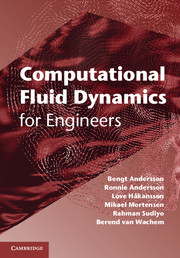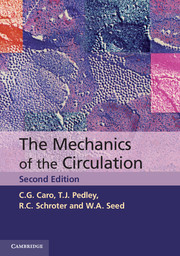3654 results in ebooks in fluid mechanics
9 - Randomly perturbed systems
- from PART TWO - DYNAMICAL SYSTEMS
-
- Book:
- Turbulence, Coherent Structures, Dynamical Systems and Symmetry
- Published online:
- 05 June 2012
- Print publication:
- 23 February 2012, pp 236-252
-
- Chapter
- Export citation
8 - One-dimensional “turbulence”
- from PART TWO - DYNAMICAL SYSTEMS
-
- Book:
- Turbulence, Coherent Structures, Dynamical Systems and Symmetry
- Published online:
- 05 June 2012
- Print publication:
- 23 February 2012, pp 214-235
-
- Chapter
- Export citation
4 - Galerkin projection
- from PART ONE - TURBULENCE
-
- Book:
- Turbulence, Coherent Structures, Dynamical Systems and Symmetry
- Published online:
- 05 June 2012
- Print publication:
- 23 February 2012, pp 106-129
-
- Chapter
- Export citation
Frontmatter
-
- Book:
- Turbulence, Coherent Structures, Dynamical Systems and Symmetry
- Published online:
- 05 June 2012
- Print publication:
- 23 February 2012, pp i-iv
-
- Chapter
- Export citation
Index
-
- Book:
- Turbulence, Coherent Structures, Dynamical Systems and Symmetry
- Published online:
- 05 June 2012
- Print publication:
- 23 February 2012, pp 382-386
-
- Chapter
- Export citation
PART THREE - THE BOUNDARY LAYER
-
- Book:
- Turbulence, Coherent Structures, Dynamical Systems and Symmetry
- Published online:
- 05 June 2012
- Print publication:
- 23 February 2012, pp 253-254
-
- Chapter
- Export citation
PART FOUR - OTHER APPLICATIONS AND RELATED WORK
-
- Book:
- Turbulence, Coherent Structures, Dynamical Systems and Symmetry
- Published online:
- 05 June 2012
- Print publication:
- 23 February 2012, pp 315-316
-
- Chapter
- Export citation
7 - Symmetry
- from PART TWO - DYNAMICAL SYSTEMS
-
- Book:
- Turbulence, Coherent Structures, Dynamical Systems and Symmetry
- Published online:
- 05 June 2012
- Print publication:
- 23 February 2012, pp 190-213
-
- Chapter
- Export citation
11 - Behavior of the models
- from PART THREE - THE BOUNDARY LAYER
-
- Book:
- Turbulence, Coherent Structures, Dynamical Systems and Symmetry
- Published online:
- 05 June 2012
- Print publication:
- 23 February 2012, pp 289-314
-
- Chapter
- Export citation

Computational Fluid Dynamics for Engineers
-
- Published online:
- 05 January 2012
- Print publication:
- 22 December 2011

The Mechanics of the Circulation
-
- Published online:
- 05 January 2012
- Print publication:
- 22 December 2011
Appendix
-
- Book:
- Computational Fluid Dynamics for Engineers
- Published online:
- 05 January 2012
- Print publication:
- 22 December 2011, pp 181-184
-
- Chapter
- Export citation
Introduction to the Second Edition
-
- Book:
- The Mechanics of the Circulation
- Published online:
- 05 January 2012
- Print publication:
- 22 December 2011, pp xxi-xxvi
-
- Chapter
- Export citation
13 - The systemic microcirculation
-
- Book:
- The Mechanics of the Circulation
- Published online:
- 05 January 2012
- Print publication:
- 22 December 2011, pp 343-425
-
- Chapter
- Export citation
4 - Turbulent-flow modelling
-
- Book:
- Computational Fluid Dynamics for Engineers
- Published online:
- 05 January 2012
- Print publication:
- 22 December 2011, pp 62-112
-
- Chapter
- Export citation
8 - Oscillations and waves
-
- Book:
- The Mechanics of the Circulation
- Published online:
- 05 January 2012
- Print publication:
- 22 December 2011, pp 105-127
-
- Chapter
- Export citation
3 - Units
-
- Book:
- The Mechanics of the Circulation
- Published online:
- 05 January 2012
- Print publication:
- 22 December 2011, pp 24-30
-
- Chapter
- Export citation
3 - Numerical aspects of CFD
-
- Book:
- Computational Fluid Dynamics for Engineers
- Published online:
- 05 January 2012
- Print publication:
- 22 December 2011, pp 24-61
-
- Chapter
- Export citation
14 - The systemic veins
-
- Book:
- The Mechanics of the Circulation
- Published online:
- 05 January 2012
- Print publication:
- 22 December 2011, pp 426-466
-
- Chapter
- Export citation
11 - The heart
-
- Book:
- The Mechanics of the Circulation
- Published online:
- 05 January 2012
- Print publication:
- 22 December 2011, pp 178-237
-
- Chapter
- Export citation
